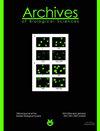Morphometric analysis of the human endoneurial extracellular matrix components during aging
IF 0.8
4区 生物学
Q4 BIOLOGY
引用次数: 0
Abstract
The aim of this study was to analyze the expression of extracellular matrix (ECM) proteins in human endoneurium during aging. We harvested 15 cadaveric sural nerves, distributed in 3 age groups (I: 25-44, II: 45-64, III: 65-86 years old). Histological sections were stained immunohistochemically for the presence of collagen type I, type IV and laminin, and the ImageJ processing program was used in morphometrical analysis to determine the percentages of these endoneurial proteins. In two younger groups, the endoneurial matrix of the sural nerve was composed from about equal proportions of these proteins, which may be considered a favorable microenvironment for the regeneration of nerve fibers. Linear regression analysis showed a significant increase in endoneurial collagen type IV with age, while collagen type I and laminin significantly decreased during the aging process. In cases older than 65 years, remodeling of the endoneurial matrix was observed to be significantly higher for the presence of collagen type IV, and lower for the expression of collagen type I and laminin. This age-related imbalance of ECM proteins could represent a disadvantageous microenvironment for nerve fiber regeneration in older adults. Our findings contribute to the development of therapeutic approaches for peripheral nerve regeneration.衰老过程中人神经内膜细胞外基质成分的形态计量学分析
本研究的目的是分析人神经内膜细胞外基质(ECM)蛋白在衰老过程中的表达。我们采集了15具尸体腓肠神经,分布在3个年龄组(I: 25-44岁,II: 45-64岁,III: 65-86岁)。对组织切片进行免疫组织化学染色,检测I型胶原、IV型胶原和层粘连蛋白的存在,并使用ImageJ处理程序进行形态计量学分析,以确定这些神经内膜蛋白的百分比。在两个较年轻的组中,腓肠神经的神经内膜基质由大约相同比例的这些蛋白质组成,这可能被认为是神经纤维再生的有利微环境。线性回归分析显示,随着年龄的增长,IV型神经内膜胶原蛋白显著增加,而I型胶原蛋白和层粘连蛋白在衰老过程中显著减少。在65岁以上的病例中,观察到IV型胶原的存在显著增加了神经内膜基质的重塑,而I型胶原和层粘连蛋白的表达则较低。这种与年龄相关的ECM蛋白失衡可能是老年人神经纤维再生的不利微环境。我们的发现有助于周围神经再生治疗方法的发展。
本文章由计算机程序翻译,如有差异,请以英文原文为准。
求助全文
约1分钟内获得全文
求助全文
来源期刊
CiteScore
1.40
自引率
0.00%
发文量
25
审稿时长
3-8 weeks
期刊介绍:
The Archives of Biological Sciences is a multidisciplinary journal that covers original research in a wide range of subjects in life science, including biology, ecology, human biology and biomedical research.
The Archives of Biological Sciences features articles in genetics, botany and zoology (including higher and lower terrestrial and aquatic plants and animals, prokaryote biology, algology, mycology, entomology, etc.); biological systematics; evolution; biochemistry, molecular and cell biology, including all aspects of normal cell functioning, from embryonic to differentiated tissues and in different pathological states; physiology, including chronobiology, thermal biology, cryobiology; radiobiology; neurobiology; immunology, including human immunology; human biology, including the biological basis of specific human pathologies and disease management.

 求助内容:
求助内容: 应助结果提醒方式:
应助结果提醒方式:


